The company Japan Rail Pass is an authorized distributor of the Japan
Rail Pass. We are not part of the Japan Railways Group (JR).
+34 93 547 88 66
» Mon-Fri 8 am to 8 pm (GMT+1)
info@jrailpass.com
» 24/7
Internet Access
Shinkansen bullet trains are the fastest way to discover Japan. Discover more about the high-speed trains and the 9 rail lines they cover.
Shinkansen bullet trains are the fastest and most convenient way of discovering Japan. The Japan Rail (JR) network is extensive and the trains reach a top speed of 320 km/h (199 mph). This allows you to get to wherever you need in little time.
The nine Shinkansen lines take you in different directions around Japan. From Tokyo to the south runs the Tokaido Shinkansen line, connecting the capital with Osaka. The Sanyo Shinkansen line connects Osaka with Fukuoka and, from there, the Kyushu Shinkansen line runs through the island of Kyushu from north to south.
The other six lines either take you north or inland from Tokyo. These are the Akita, Hokkaido, Hokuriku, Joetsu, Tokoku, and Yamagata Shinkansen lines. The Hokkaido line takes you the furthest north, all the way to Hokkaido island.
The Japan Rail Pass gives you unlimited access to all Shinkansen high-speed trains.
The JR Pass also allows you to make seat reservations free of charge. You can make seat reservations at any JR Ticket Office or ticketing machine in any JR station.
A supplement is required for travel on the Nozomi and Mizuho express trains on the Tokaido, Sanyo and Kyushu Shinkansen lines. This special complementary ticket can be bought at ticket machines or station counters in Japan, and it’s cheaper than riding a Nozomi or Mizuho train without the JR Pass.
The Hikari and Sakura bullet trains are the fastest trains you can board using the Japan Rail Pass without a supplement. They make just a few more stops than the Nozomi and Mizuho trains.
It’s worth noting that several of the JR Regional Passes also cover certain trips on Shinkansen bullet trains.
On each of the Shinkansen lines there are fast trains, semi-fast trains, and local trains:
For instance, on the Tokaido Shinkansen line (which links Tokyo to Osaka) the fast train makes 6 stops, the semi-fast train makes between 7 and 12 stops, and local trains stop at all 17.
The Shinkansen railway network includes several lines that cover most of Japan and connect all the main cities.
Thanks to this great railway system you can travel quickly and comfortably throughout the country without too much of a second thought.
The companies that make up the JR Group operate a total of 9 lines: 7 Shinkansen lines, and 2 mini-Shinkansen lines. Each line offers different train services.

The Tokaido Shinkansen line is Japan’s busiest and most popular line. It connects the three biggest metropolitan areas of the country: Tokyo to Yokohama, Osaka to Kyoto, and Nagoya.
It is also famous for being Japan’s first high-speed railway, opening in 1964 for the Japan Olympic Games.
The line is managed by the Central Japan Railway Company, commonly referred to as JR Central or JR Tokai.
Three types of train operate on this line: Nozomi, Hikari and Kodama.

Nozomi trains connect Tokyo to Shin-Osaka in 2.5 hours, serving only major stations along the route. Typically, there are 4 trains departing per hour in both directions, with additional services during peak times. Many Nozomi trains extend their journey past Shin-Osaka, traveling along the Sanyo Shinkansen to destinations like Hiroshima or Hakata.
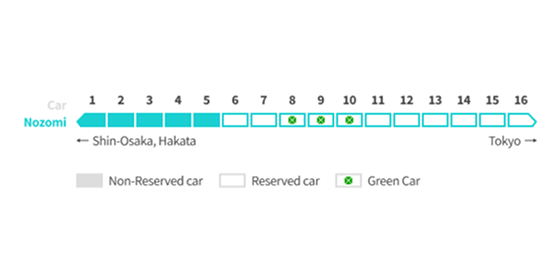
The Hikari train connects Tokyo to Shin-Osaka in exactly 173 minutes. The maximum operating speed is 285 km/h (178 mph), which makes it the second-fastest train on the Tokaido Shinkansen line. Hikari also runs on the Sanyo Shinkansen line with an operating speed of 300 km/h (185 mph).
It's worth noting that some Hikari services make the same number of stops as Nozomi trains.
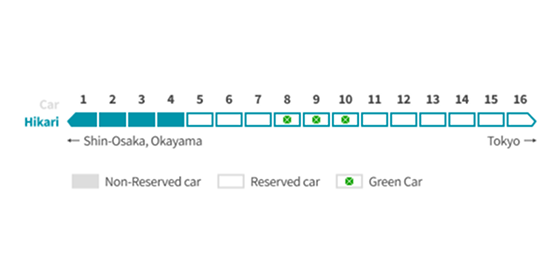
Kodama is the slowest of the three trains which operate on the Tokaido Shinkansen line. This is due to the larger number of stops in comparison to the other two bullet trains on this line. The Kodama train stops at every station and takes almost four hours to reach Shin-Osaka. It runs at a speed of 285 km/h (178 mph).
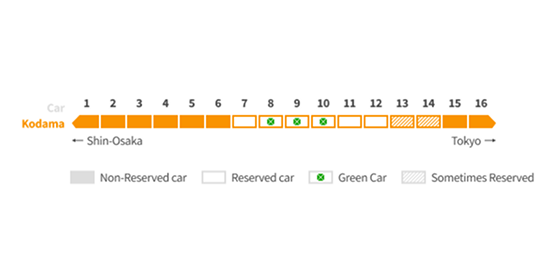
The Sanyo Shinkansen line connects the city of Osaka with Fukuoka on the island of Kyushu, and is run by the West Japan Railway Company, or JR West. Completed in 1975, it is the second oldest Japanese Shinkansen line. There are 5 train services that run on this line: Nozomi, Hikari, Kodama, Mizuho, and Sakura.

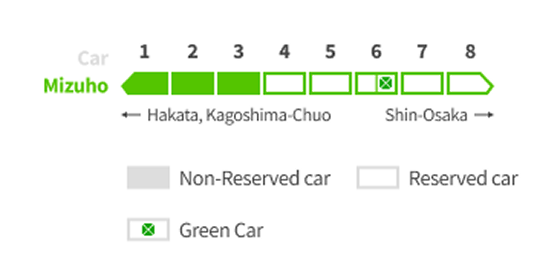
This is one of the fastest train services operating on the Sanyo Shinkansen line. Its operating speed is 300km/h (185mph), similar to the other trains on the same line, but the Sakura trains make more stops than the Mizuho. It operates with 8-car trains with both reserved and non-reserved sections. There are also some Green Class seats on one of the cars.
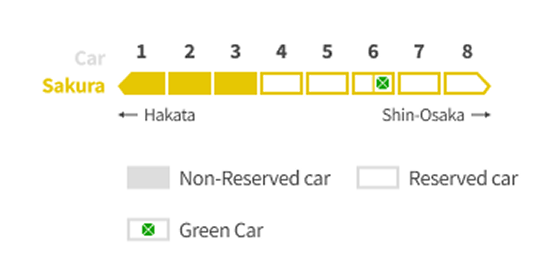
Note that not all Nozomi services stop at all the stations outlined above.

Hikari is the fastest train service on the Sanyo and Tokaido Shinkansen lines which is fully covered by the JR Pass. The majority of Hikari trains are formed of 16 cars though some have 8. There are three Green Class cars on the 16-coach Hikari train. The operating speed of the Hikari train is 300 km/h (185 mph). It takes a little over an hour to reach Okayama from Shin-Osaka.

This is the slowest train service on the Sanyo line, as it stops at all train stations until it reaches its final destination. Because of this, Kodama trains take almost five hours to arrive at Hakata station from Osaka.
The trains have 8 cars but no Green Class cars. There are both reserved and non-reserved seating areas on the Kodama train service. The operating speed of the Kodama train is 300 km/h (185 mph).

The Tohoku Shinkansen line connects Tokyo with Aomori and is operated by the East Japan Railway Company, or JR East. The line was opened in 1982 and later extended to Aomori in 2010. There are 4 different train services which run on the Tohoku line: Hayabusa, Hayate, Yamabiko, and Nasuno.

Hayabusa is the fastest train in Japan, reaching a maximum speed of 320 km/h (200 mph). There is a direct train connecting Tokyo to Shin-Aomori in just 189 minutes.

Yamabiko is a high-speed Shinkansen. It operates at a speed of 240 km/h (150 mph) and connects Tokyo with Morioka. There is a direct train service that will take you to Morioka in exactly 198 minutes.
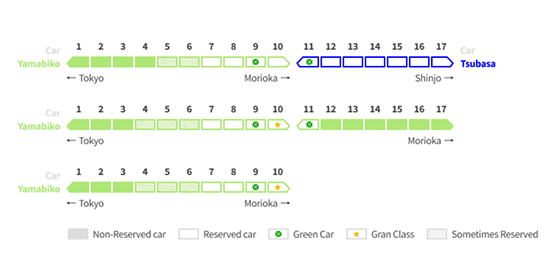
The Nasuno serves all the stations between Tokyo and Koriyama. It is the slowest type of train on the Tohoku Shinkansen line and it is designed for commuters who travel from the Fukushima and Tochigi Prefectures.
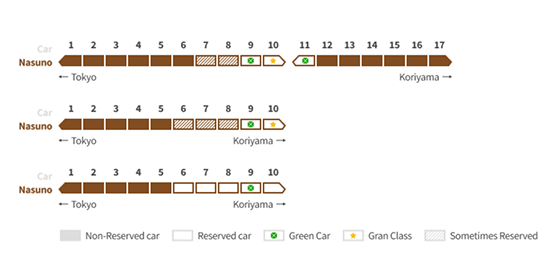
The Akita Shinkansen, operated by JR East, is a branch of the Tohoku Shinkansen line which connects Tokyo with Akita. The Komachi train is the only type of train which runs on the line. It is an E6 series, also known as the Super Komachi.

All seats on the Komachi train services requires seat reservation. There is a direct train service from Tokyo to Akita which takes exactly 237 minutes. The Komachi train can run at a maximum speed of 320 km/h (200 mph) on the Tohoku line. The Komachi train services are operated by E6 series trains with 7 coaches.
Between Tokyo and Morioka, the Komachi trains are coupled with Hayabusas Shinkansens to form 17-car trains. The Komachi trains detach from the Hayubasas at Morioka and run to Akita.
Note that some Komachi trains do not stop in Shizukuishi.
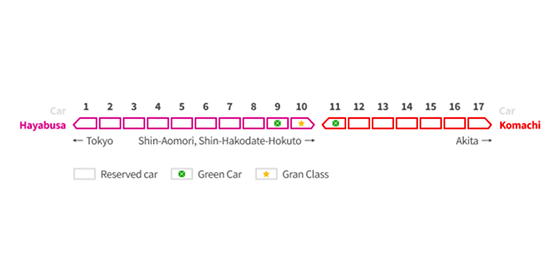
Yamagata Shinkansen, run by JR East, is a Tohoku Shinkansen branch line. Tsubasa is the only type of train that runs on the Yamagata line between Tokyo and Shinjo. Tsubasa services are operated by 7-car E3 series trains.

Seat reservtions are mandatory on Tsubasa trains. There is a direct train service from Tokyo to Yamagata which takes 165 minutes. The maximum operating speed of the Tsubasa train is 275 km/h (170 mph).
Note that some Tsubasa trains do not stop in Takahata.
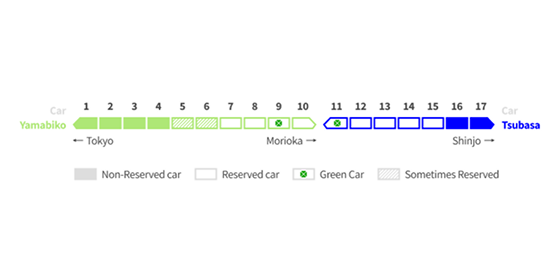
The Joetsu Shinkansen line, operated by JR East, dates back to 1982. It connects travelers between Tokyo and the hot springs and leisure resorts of Niigata and the surrounding area. Toki and Tanigawa are the two train categories that operate on the line.

Toki trains are the fastest service on the Joetsu Shinkansen. The operating speed of the train is 240 km/h (150 mph). The Toki Shinkansen takes you from Tokyo to Niigata in just over an hour and a half.
Note that only certain Toki trains make the 7 additional stops between Omiya and Niigata.
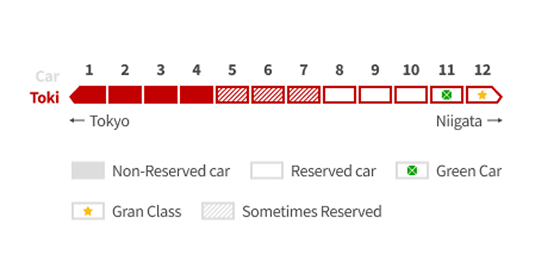
This is the slower of the two types of trains which operate on this line (Toki and Tanigawa). This is because Tanigawa Shinkansen stops at all train stations between Tokyo and Echigo-Yuzawa and is primarily a commuter train.
During the winter season, the train reaches Gala-Yuzawa, getting travelers to the nearby ski resort.
The Tanigawa Shinkansen takes you from Tokyo to Echigo-Yuzawa in a little over an hour. The operating speed of the train is 240 km/h (150 mph).
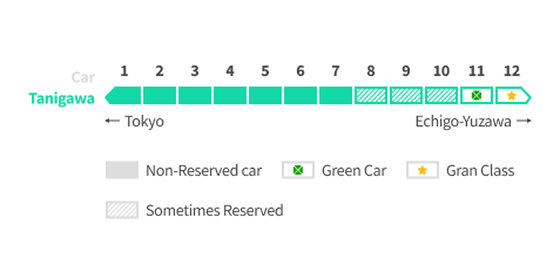
The Kyushu Shinkansen line, operated by JR Kyushu, connects Fukuoka with Kagoshima-Chuo. There are three types of trains which operate on the Kyushu Shinkansen line: Tsubame, Sakura, and Mizuho.
A branch line, the Nishikyushu Shinkansen, connects Takeo-Onsen and Nagasaki with Kamome train services.

Mizuho trains are the fastest on the Kyushu Shinkansen, stopping only at Kumamoto between Hakata and Kagoshima-Chuo. Only a limited number of round trips are available each day, primarily scheduled for the mornings, late afternoons, and evenings.
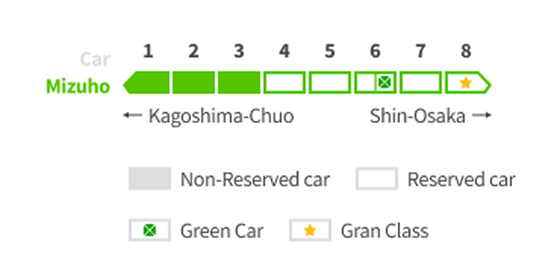
The Sakura train is the second fastest train on the Kyushu line, serving fewer train stations than Tsubame Shinkansen trains. There are two different types of Sakura trains: 8-car and 6-car trains.
The larger one offers both Standard and Green Class cars, while the smaller one only has Standard cars.
The operating speed is 300 km/h (185 mph). It takes approximately an hour and twenty minutes to reach Hakata from Kagoshima-Chuo Station.
Note that certain Sakura trains make 3 extra stops between Kumamoto and Sendai.
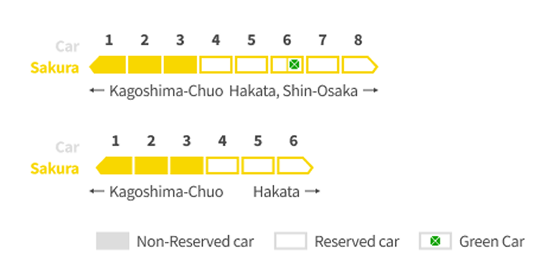
Tsubame is the slowest of the trains operating on the Kyushu Shinkansen line as it stops at all stations until it reaches its final destination. It is also has the fewest cars and there are no Green Class ones.
The operating speed of Tsubame trains is 260 km/h (160 mph). A trip from Kagoshima-Chuo to Hakata with the Tsubame train will take you a little over an hour and forty minutes.
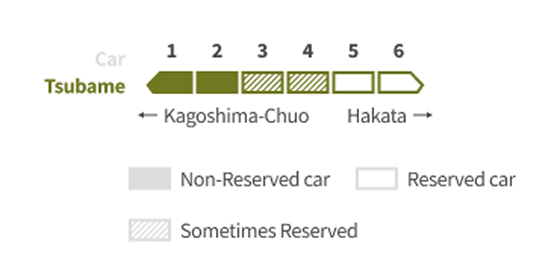
Kamome is the only train service that runs on the Nishikyushu Shinkansen branch line between Nagasaki and Takeo Onsen. In the future, the trains are expected to run as far as Hakata, but at the moment a Limited Express train called “Relay Kamome“ connects Takeo Onsen with Shin-Tosu and Hakata.
Note that not all of the trains stop at Ureshino-Onsen and Shin-Omura.
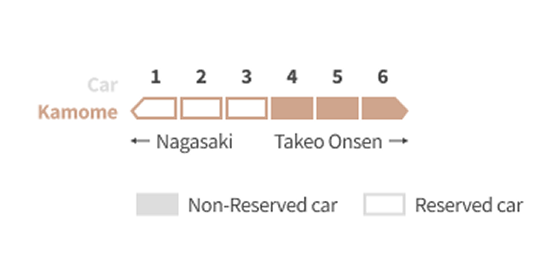
The Hokkaido Shinkansen line connects Aomori (on the main island - Honshu) with Hakodate (on Hokkaido island) via the Seikan Tunnel. It is run by JR Hokkaido. The line will be extended to Sapporo by 2030.

The majority of the trains which run on the Hokkaido line are Hayabusa Shinkansen trains. They operate between Tokyo and Hakodate with a top speed of 320 km/h (200 mph).
The journey from Tokyo to Hakodate takes approximately 280 minutes. The Hayabusas go all the way to Shin-Hakodate-Hokuto, a station located between Hakodate and Hokuto. From there, you can take the local Hakodate Liner to get to Hakodate in 19 minutes.
Note that some Hayabusa trains go directly from Shin-Aomori to Shin Hakodate Hokuto without stopping at Oku Tsugaru Imabetsu or Kikonai.
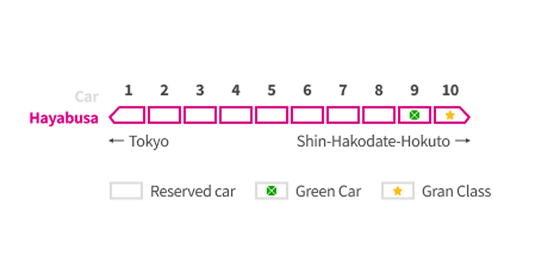
The Hokuriku Shinkansen line was originally opened in 1997 for the Nagano Olympic Games and was previously known as Nagano Shinkansen. The line currently stretches from Tokyo to Tsuruga and is operated by JR East and JR West. There are four types of trains that operate the Hokuriku line: Kagayaki, Asama, Hakutaka, and Tsurugi.

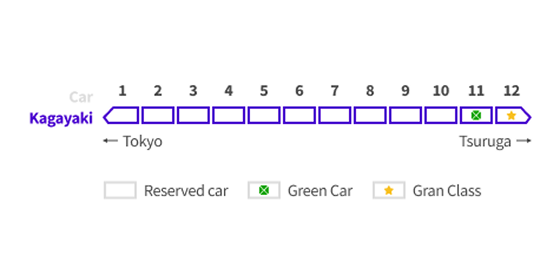
The name Asama comes from the name of an active volcano on Mount Asama, located near Karuizawa. Asama services have 12-coach trains with both reserved and non-reserved cars, and Green Class and Gran Class cars.
Note that some Asama trains make 3 additonal stops between Tokyo and Nagano.

The Hakutaka and Kagayaki trains are the only two on the Hokuriku Shinkansen line that run from Tokyo all the way to Tsuruga. Hakutaka is the slower of the two trains as it makes more stops. The operating speed of Hakutaka trains is 260 km/h (160 mph). A trip from Tokyo to Tsuruga takes just around 3 hours and 50 minutes.
Note that some Hakutaka trains make up to 4 additional stops between Tokyo and Joestsu-Myoko.
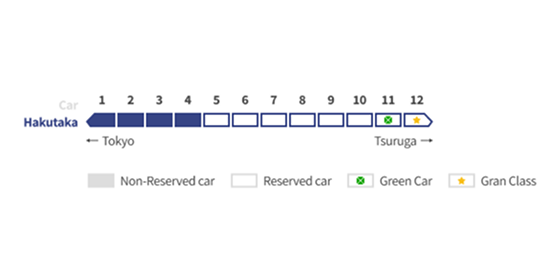
The Tsurugi train serves as the main connection for locals between Toyama and Kanazawa. The trains are formed of 12 cars including a Green Class and Gran Class car.
Note that some Tsurugi trains make up to 4 extra stops between Kanazawa and Tsuruga.
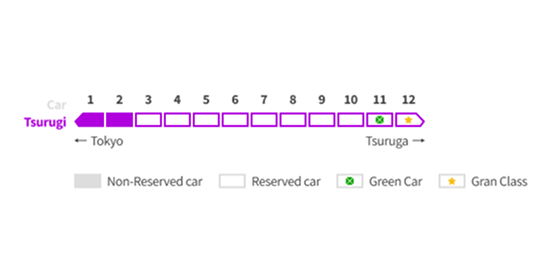
If you don’t have a JR Pass you can buy bullet train tickets individually. The ticket prices depend on the distance of the journey, whether you reserve a seat, and which class of ticket you choose. You can buy Shinkansen tickets at train stations or online (through the websites of individual JR operators).
The price of a basic Shinkansen ticket is made up of base fare and limited express fee (Shinkansen supplement), in addition, if required, is possible add a seat reservation fee and Green car fee.
There is now free WiFi on most Shinkansen trains running on all lines. Learn more about WiFi on the Japanese bullet trains.
Passengers are allowed to take their bicycle with them on board for no additional fee. However, its front wheel needs to be removed (unless it is a foldable bike) and it needs to be stored in a bike bag.
Small pets such as cats, dogs, and birds are allowed on board as long as they weigh less than 10 kg, are shorter than 90 cm in length, and are safely put into a container.
Travellers are allowed luggage on board for no additional cost. However, there is a limitation of two pieces of luggage.
All luggage items must fall within the size and weight ranges permitted:
There is a delivery service option.
Travellers with oversized bags (length, height, and depth dimensions over 160 cm and up to a maximum of 250 cm) will be required to make a seat reservation in the last row of seats on the train, in front of the oversized luggage area.
The Tokaidō (Tokyo to Osaka), Sanyo (Osaka to Fukuoka), and Kyushu (Fukuoka to Kagoshima) Shinkansen no longer have separate baggage compartments, meaning that the oversized luggage area is the only space for large items.
It will not be possible to bring oversized luggage into non-reserved cars on the specified lines. Passengers who have not made a seat reservation will be required to move their luggage to the designated area and pay a ¥1,000 surcharge not covered by the Japan Rail Pass.
Certain items can be brought onto the Shinkansen regardless of size and do not require a reservation unless you plan to put them in the oversize baggage area:
The bullet trains are very easy to access for passengers in wheelchairs and parents with strollers and the stations are well-equipped with elevators and escalators.
You can book special seating free of charge if you are in a wheelchair. The only requirement is that you make this request two days in advance at the train station where you will board.
Strollers are also allowed on board free of charge. The only requirement is for them to be folded and safely placed in the designated places.
Shinkansen Nozomi and Mizuho high-speed trains (reserved and non-reserved seats) are included in the JR Pass.
To travel on these trains, a special ticket must be purchased at ticket machines or station counters in Japan.
However, there are alternatives to the Nozomi and Mizuho services which you can access at no extra charge.
Japan Rail Pass holders are entitled to book a seat on all Japan Railways trains free of charge. All seats should be booked before boarding the train. The JR Group does not allow to change to a reserved seat once you have boarded the train.
The Japan Rail Pass is valid on the JR Express Trains, all Rapid and Local trains along the JR lines, JR local buses, the JR Miyajima ferry, as well as airport transfers like the Narita express and the Haruka express. Shinkansen high-speed trains are also covered.
The Japan Railways lost property service is excellent. If you have lost something on a JR train, there is a good chance that you’ll recover your belongings. When a member of staff finds something on a Japan Rail train, they hand it to one of the lost and found counters, where it is kept for around one week. After this, the lost property is transferred to the regional Police Lost and Found Center.